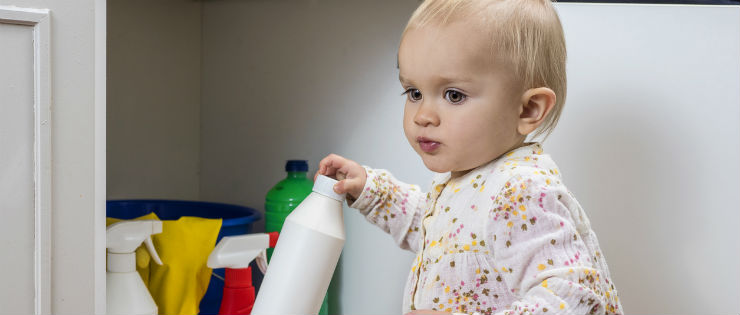
The toddler years are a dangerous time for potential poisonings. Young children are often exploring and getting into mischief as they are naturally inquisitive. Much of what they find goes into their mouth and so a poisoning can occur within minutes when a parent's back is turned.
Common Poisons
There are thousands of products that can cause poisoning in children. These are some of the more common ones that present to hospitals each year.
Cleaners
Toilet bowl cleaners, bleach, oven and BBQ cleaners, surface cleaners and hand sanitisers are often left within easy reach of young children and cause damage when ingested or spilt on their skin.
Drugs
Prescription, over the counter and illicit drugs are also common in childhood poisonings. Parents may not realise that their child can open and swallow paracetamol, antihistamines, antidepressants, flu tablet and illegal drugs. Even a quantity of vitamin tablets is dangerous when ingested by children.
Poisonous Plants
Some plants found in thousands of residential gardens around Australia are poisonous if swallowed by a child. These plants produce toxins to defend themselves from insects and animals. Some of these popular plants include poinsettia, oleander, arum lily and angel's trumpet.
Batteries
Many children swallow or insert button batteries in their ear or nose. Found in toys and watches, these shiny batteries can lodge in the oesophagus or burn through the intestinal wall or vital organ within hours of being swallowed. Death can occur if a parent is unaware that their child has swallowed a battery.
Forms of Poisoning
While it is the most common form, not all poisonings occur from swallowing. Anyone can be poisoned by a solid, liquid or gas being breathed in or absorbed through the skin. Household paint, for example, is dangerous if brushed on to a large portion of skin and absorbed into the bloodstream. Using a heater or fire in an area that is not well ventilated is also a poisoning risk.
Different poisons can cause different reactions from vomiting, seizures, blurred vision and unconsciousness.
Keeping Children Safe
If you have young children living in or visiting your house, it is important to keep them safe by securing all substances that are potentially harmful. Not all dangerous products have a warning label on them. Often people think about moving bleach and other chemicals to a high shelf but leave other potentially harmful substances within easy reach of children.
Some of the less obvious potentially poisonous substances include:
Alcohol
Dishwasher tablets
Cosmetics
Gardening products
Batteries
Some plants
Medications
What to Do
In poisoning cases, early first aid treatment is important. Keep any packaging or sample of the poison when you call for information or take your child to a hospital to assist medical staff.
1. Try to find out how much has been ingested and call an ambulance or the poisons information line. Seek advice or medical attention early rather than waiting for symptoms to show.
2. Do not induce vomiting until you have gained medical advice. If your child has eaten a corrosive product such as a cleaning product, the substance can burn on the way up doing more damage.
3. Encourage your child to rinse their mouth with milk or water then take small sips.
4. Begin CPR if your child loses consciousness.
Telephone Information Line
The 24-hour Poisons Information Centre is available from anywhere in Australia on 13 11 26 for information.
HIF Ambulance Cover
We hope you will never need to call an ambulance, but if you do you will want the fees covered. Check out HIF’s Ambulance Cover for details of benefits in your state.